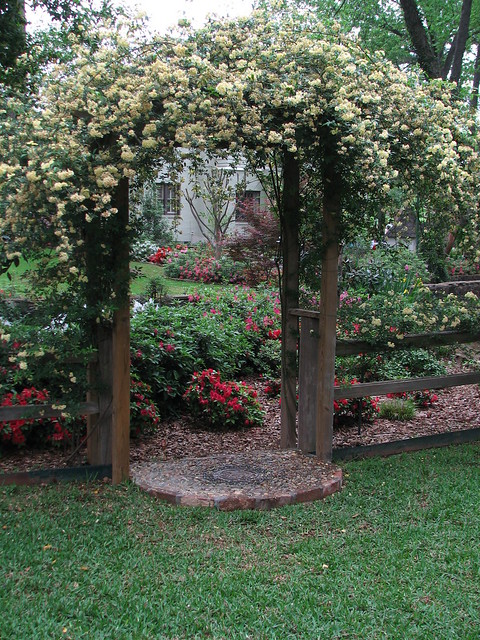Resource Library
Plant of the Week: Rosa banksiae Lady Banks Rose
Zone lust is a peculiar ailment of gardeners and snowbirds. We always long for growing conditions that are different than where we are. Recently, I happened upon a Lady Banks rose (Rosa banksiae) in full bloom and suffered a severe case of zone lust.
Lady Banks rose is a big, sprawling evergreen rose capable of producing branches 20 feet or more in length. It has compound, glossy green leaves with three or, more often, five leaflets with each leaflet to 2 ½ inches long. Unlike most roses, this climber is essentially thornless, making it easy to have in the garden.
The multi-petaled flowers are produced in dense terminal clusters and are to an inch across and either white, pale yellow or yellow. Blooms appear in late spring and continue for about a month. Flowers are mildly fragrant. Though the original species is white flowered the yellow flowered cultivar “Lutea” is the most common form seen in southern gardens.
Lady Banks rose arrived in England in 1807 from China thanks to William Kerr, a plant hunter sent by Sir Joseph Banks who directed London’s Kew Gardens. Kerr, for whom the flowering shrub Kerria is named, introduced 238 plants to cultivation in the West but did so mainly by purchasing plants from Chinese nurseries. Botanists at Kew, in deference to their employer, named the new rose after the boss’s wife. The yellow flowered “Lutea” was brought back to England in 1824 by J.D. Parks.
Lady Banks rose has no counterpart in the wild, so it was developed or selected by some Chinese gardener several centuries before it was “discovered” by botanists in the West. This kind of plant is called a “cultigen,” a plant with no actual counterpart in the wild. Though the plant is popular in Chinese gardens it is not commonly shown in classic Chinese paintings.
Lady Banks rose is an easy-to-grow rose, for it suffers from few of the leaf diseases such as black spot and mildew that devastate many of our modern roses. It is best in full sun or light shade in any well-drained garden soil. It is winter hardy in zones 7-9. Though Fayetteville sits on the dividing line between zones 6 and 7, I have had no success getting it to overwinter in our area.
This rambling rose is used to cover things such as archways, trellises, fences and even buildings. Though it is a rambunctious grower its size can be easily controlled by annual pruning after the blooms have finished in the spring.
For more information about horticulture or to see other Plant of the Week columns, visit Extension's Web site, www.uaex.uada.edu, or contact your county extension agent. The Cooperative Extension Service is part of the U of A Division of Agriculture.
Pursuant to 7 CFR § 15.3, the University of Arkansas System Division of Agriculture offers all its Extension and Research programs and services (including employment) without regard to race, color, sex, national origin, religion, age, disability, marital or veteran status, genetic information, sexual preference, pregnancy or any other legally protected status, and is an equal opportunity institution.
